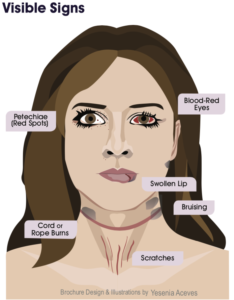Strangulation
Strangulation has only recently been identified as one of the most lethal forms of domestic violence: unconsciousness may occur within seconds and death within minutes. When domestic violence perpetrators choke (strangle) their victims, not only is this a felonious assault, but it may be an attempted homicide. Strangulation is an ultimate form of power and control, where the batterer can demonstrate control over the victim’s next breath; having devastating psychological effects or a potentially fatal outcome.
Sober and conscious victims of strangulation will first feel terror and severe pain. lf strangulation persists, unconsciousness will follow. Before lapsing into unconsciousness, a strangulation victim will usually resist violently, often producing injuries of their own neck in an effort to claw off the assailant, and frequently also producing injury on the face or hands to their assailant. These defensive injuries may not be present if the victim is physically or chemically restrained before the assault.
Observing Changes
Documentation by photographs sequentially for a period of days after the assault is very helpful in establishing a journal of physical evidence.
Victims should also seek medical attention if they experience difficulty breathing, speaking, swallowing or experience nausea, vomiting, lightheadedness, headache, involuntary urination and/or defecation, especially pregnant victims. A medical evaluation may be crucial in detecting internal injuries and saving a life.
Losing Consciousness
Victims may lose consciousness by any one or all of the following methods: blocking of the carotid arteries in the neck (depriving the brain of oxygen), blocking of the jugular veins (preventing deoxygenated blood from exiting the brain), and closing off the airway, making breathing impossible.
Signs of Strangulation
-
Head- pinpoint red spots (petechiae ) on scalp, hair pulled, bump(s), skull fracture, concussion
-
Face- red or flushed, petechiae, scratch marks
-
Eyes and Eyelids- petechiae to the left or right eyeball
-
Ear- petechiae (external and/or ear canal), bleeding from ear canal.
-
Nose- bloody nose, broken nose, petechiae.
-
Mouth- bruising, swollen tongue, swollen lips
-
Under the chin- redness, scratch marks, bruise(s), abrasions
-
Neck- redness, scratch marks, fingernail impressions, bruise(s), abrasions, swelling, ligature marks.
-
Chest and Shoulders- redness, scratch marks, bruise(s), abrasions
Symptoms of Strangulation
-
Voice changes- raspy and/or hoarse voice, coughing, unable to speak, complete loss of voice.
-
Swallowing changes- trouble swallowing, painful swallowing, neck pain, nausea/vomiting, drooling.
-
Breathing changes- difficulty breathing, hyperventilation, unable to breathe.
-
Behavioral changes- restlessness or combativeness, problems concentrating, amnesia, agitation, Post-traumatic Stress Syndrome, hallucinations.
-
Vision changes- complete loss or black & white vision, seeing ‘stars’, blurry, darkness, fuzzy around the eyes.
-
Hearing changes- complete loss of hearing, gurgling, ringing, buzzing, popping, pressure, tunnel-like hearing.
-
Other changes- Memory loss, unconsciousness, dizziness, headaches, involuntary urination or defecation, loss of strength, going limp.
Rainbow House Domestic Abuse Services, Inc.
Main Office/Shelter:
1530 Main St. #1172 Marinette, WI 54143
Outreach Office:
1008-B Oconto, WI 54153
Contact Number: 800-956-6656 (toll free) 715-735-7293 (fax)



